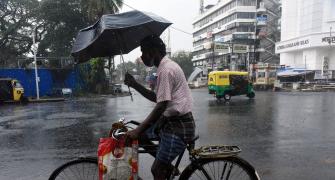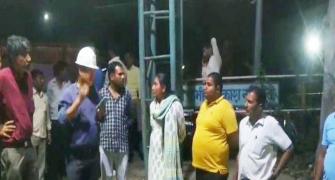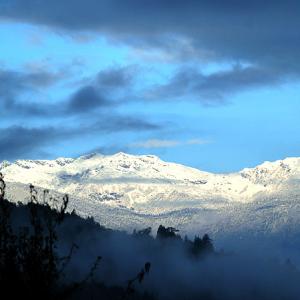A below-average rain in winter, coupled with changes in the very nature of the forest of the region, is taking a toll on the state of Uttarakhand. Nitin Sethi reports.

As rainfall in the upper reaches of Uttarakhand and Himachal Pradesh starts to have salutary effects on the raging forest fires, the National Green Tribunal has issued notices to the two hill states on the matter, listening to a petition before its Delhi bench.
The reasons behind a spate of forest fires in the hills this year, though, could be multi-fold.
"The winter saw below average snow-fall this year. The melting snow helps keep the mountain floors moist as winter ends. That has not happened. The winter rain in Uttarakhand and Himachal Pradesh was also lower this year -- we have had practically a six-month dry spell," says a senior official at the Indira Gandhi National Forest Academy, Dehradun, who does not want to be named.
"The fact that the region has been exceptionally dry is the main reason that even some oak and deodar forests have caught fire this time," he says.
Oak and deodar trees, historically more common to these two states, can retain greater amounts of moisture in the surface litter, the soil and sub-soil, than the chir pine trees which now occupy large swathes of the forest land in the state.
The month of March-April saw all districts of Uttarakhand, except for Nainital, face a deficit rainfall with more than half the districts receiving 40 per cent lower rain than normal, shows data from the meteorology department.
The entire North-Western region, including the two hill states, had seen the rainfall deficit climb by the end of February to 65 per cent below normal.
A trend of lower winter rain across the two states is evident from rainfall statistics of the past five years, with some districts seeing absolutely dry months for more than three out of the past five years.
Another senior forest officer, in charge of one of the wildlife sanctuaries in the state, says, "Coupled with the high ambient temperatures and extensive dry spell, we also had a high wind factor this time. This carried the dry leaves on fire wider than usual. But it's been a ground fires largely, not a canopy fire."
But this raises the question of preparedness of the state forest departments to deal with an impending crisis.
Usually the forest departments in the hills have a built-in annual regime to create fire-lines in identified sensitive areas - this helps contain fires.
A large number of villagers are hired on voluntary basis and some as part-time workers in many parts of the country to do this work as the forest department lacks enough manpower.
"Fire-lines management has always faced the trouble of timing. Fire-lines have to be built in February-March but the budget gets finalised in April and sanctions come later. We have traditionally worked on the understanding that payments will come a few months later," the senior officer says.
But he admits that this year wasn't any different from the previous year as far as fire management was concerned except the forest fire season peaked earlier than usual with the temperatures soaring.
Villagers in the hills have traditionally also used controlled fires to increase the productivity of their land -- the emerging undergrowth of the new season, fed on rain or snow melt, gets additional nourishment from the burnt floor litter to help improve growth of new grass and herbs.
Silviculture practices taught to forest officials also include training on intelligent use of fire to increase forest produce.
"Definitely this science of forestry has taken a back seat with the ban on timber felling in the hills (imposed by the Supreme Court)," says the officer.
To add to it, the spread of chir pine has made the hills more combustible.
It's a species of tree that soaks water and leaves the floor of the forest dry covered with pine needles that are more prone to fire.
At the same time, migration of youth from the hills has reduced the number of hands available to prepare the communities for the summer season. Stacking up of fallen pine needles in panchayat forests was a common practice in hill villages. That community management has now crumbled with time.
"Besides the greater spread this year, the messages of crisis are reaching down from the hills faster now," says a retired forest official in the state.
However, could the forest department offices have been better informed today than in the era when the wireless system was the only communication link to range offices in the hills?
The ground-level information collection is one way. The other is satellite-based systems.
India has had the Indian Forest Fire Response and Assessment System, run out of the Vikram Sarabhai Space Centre by the National Remote Sensing Authority run, since 2005.
The system provides almost real-time alerts to states that desire it. The data is available in public domain as well on the Bhuvan website run by the Indian Space Research Organisation now.
At the moment, this satellite-imagery is big enough to help forest officials locate the fires for early-warning signs. The satellite-data is also available for previous years to show regions and pockets that are prone to forest fires in specific months.
Could it have been used more pro-actively?
Perhaps, if the information coming from satellite imagery and the meteorological department was processed for warning signs, people would have know that 2016 wouldn't be a usual year in the hills.











